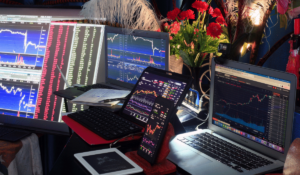Introduction
In the world of forex trading, there are various strategies that traders employ to navigate the markets and seek profitable opportunities. One such strategy is grid trading, which allows traders to take advantage of price trends and market movements. In this comprehensive guide, we will delve into the intricacies of grid trading, exploring its definition, how it works, the different types of forex grids, the pros and cons of this strategy, and the use of grid trading bots. Whether you are a beginner or an experienced trader, this guide will provide you with valuable insights and knowledge to enhance your trading skills.
What is Grid Trading?
Grid trading is a strategy employed by traders to profit from price trends and market movements. The concept behind grid trading involves placing buy and sell orders above or below the current market price at specific intervals. This approach allows traders to capitalize on price fluctuations and potentially generate profits in both trending and consolidating markets.
How Grid Trading Works
To understand how grid trading works, let’s consider an example using the GBP/USD currency pair. Suppose the current market price is 1.2725. In a grid trading scenario, a trader may place buy orders at increasing levels above the current price and sell orders at decreasing levels below the current price. By doing so, the trader aims to benefit from the price moving in either direction.
Types of Forex Grids
There are two main types of trading grids: pure trading grids and modified trading grids.
- Pure Trading Grid: In a pure trading grid, both buy and sell orders are placed, regardless of the market’s direction or range. This type of grid is not influenced by whether the market is trending or consolidating.
- Modified Trading Grid: The modified trading grid takes into account the market’s current direction. Traders using this type of grid consider factors such as technical indicators or fundamental analysis to determine their directional bias. The modified trading grid is designed to capitalize on trending markets.
Reasons to Use Grid Trading
Grid trading offers several advantages that make it an appealing strategy for traders:
- Simplified Trading: Grid trading eliminates the need for complex technical indicators or fundamental analysis. Traders can focus on selecting key levels for entry and exit, set up their grid, and let it execute trades. This simplification streamlines the trading process.
- Position Sizing Flexibility: Grid trading allows traders to gradually increase their position size by entering smaller positions incrementally. This approach reduces the risk associated with entering one large position and provides more control over risk management.
- Profit Potential in Both Trending and Consolidating Markets: With a pure trading grid, traders can potentially profit from both trending and consolidating markets. By placing buy and sell orders at different levels, traders can capture price movements in either direction.
- Automation Possibilities: Grid trading can be easily automated using trading bots. These bots can execute trades based on predetermined rules, freeing up traders’ time and minimizing emotional decision-making.
Considerations and Risks of Grid Trading
While grid trading offers various benefits, it is essential to be aware of the potential risks and considerations associated with this strategy:
- Market Volatility: In fast-moving markets with high volatility, entries and exits may not align with the predetermined levels set in the grid. This discrepancy can affect risk/reward parameters and the overall performance of the grid.
- Profit-Taking Temptation: Grid trading relies on riding market waves to generate profits. However, there is a temptation to take profits early, which can lead to larger losing trades and significant drawdowns. Traders must exercise discipline and stick to their predetermined exit rules.
- Swap Fees: In consolidating markets, where the price remains within a narrow range, traders may incur substantial swap fees. If orders are triggered but the market does not exhibit significant movement for an extended period, traders could end up holding multiple positions and paying overnight costs.
Grid Trading Bots
Grid trading can be further enhanced through the use of trading bots. These automated systems execute trades based on predefined rules and parameters. Here’s what you need to know about grid trading bots:
What is a Grid Trading Bot?
A grid trading bot is a software program that automates the execution of trades based on a predefined grid trading strategy. Traders can input their entry and exit rules, and the bot will monitor the market and execute trades accordingly.
Advantages of Using a Grid Trading Bot
- Emotion-Free Trading: Grid trading bots minimize emotional decision-making by executing trades based on predefined rules. This eliminates the temptation to make impulsive trading decisions driven by fear or greed.
- Backtesting Capabilities: To use a grid trading bot effectively, traders must define specific rules for entry and exit points. This requirement encourages backtesting, allowing traders to fine-tune their strategy and optimize their grid parameters.
Common Queries about Grid Trading
- Is grid trading suitable for beginners?
Grid trading is not recommended for beginner traders. It requires a solid understanding of market dynamics, risk management, and trading strategies. It is advisable for new traders to first gain experience and knowledge in basic trading techniques before attempting grid trading. - Can grid trading be used in conjunction with other strategies?
Yes, grid trading can be combined with other trading strategies. Traders often incorporate grid trading as part of their overall trading approach to diversify their trading portfolio and capture different market conditions. - Are there specific currency pairs or markets where grid trading works best?
Grid trading can be applied to various currency pairs and markets. However, it is important to consider the liquidity, volatility, and trading hours of the chosen market. Highly liquid and volatile markets tend to provide more trading opportunities suitable for grid trading. - What is the ideal grid size and spacing?
The ideal grid size and spacing depend on the trader’s risk tolerance, account size, and market conditions. A smaller grid size with tighter spacing may generate more frequent trades but also increase exposure to market fluctuations. Traders should carefully consider these factors when determining their grid parameters. - How can I manage risk in grid trading?
Risk management is crucial in grid trading. Traders should set appropriate stop-loss levels for each grid level to limit potential losses. Additionally, position sizing should be carefully calculated to align with the trader’s risk tolerance and account size. - Can grid trading be applied to other financial markets besides forex?
While grid trading is commonly associated with forex markets, it can also be applied to other financial markets such as stocks, commodities, and cryptocurrencies. The principles of grid trading remain the same, but traders should adapt their strategies to the specific characteristics of each market.
Key Takeaways
- Grid trading is a strategy that allows traders to profit from price trends and market movements.
- There are two main types of forex grids: pure trading grids and modified trading grids.
- Grid trading offers advantages such as simplified trading, position sizing flexibility, profit potential in trending and consolidating markets, and automation possibilities.
- Traders must consider risks and factors such as market volatility, profit-taking temptation, and swap fees when implementing grid trading.
- Grid trading bots can automate the execution of trades based on predefined grid strategies, minimizing emotional decision-making and providing backtesting capabilities.
- Beginner traders should focus on learning basic trading techniques before attempting grid trading, and risk management is crucial in grid trading to protect against potential losses.
Grid trading can be a powerful tool in a trader’s arsenal when used correctly and with proper risk management. As with any trading strategy, it is important to continuously learn, adapt, and refine your approach based on market conditions and personal experience. By combining knowledge, discipline, and the right tools, traders can harness the potential of grid trading to navigate the dynamic forex markets successfully.








